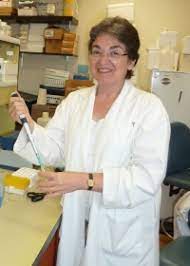Spotlight on Canadian Research
As part of Lupus Canada’s initiatives to support research and educate Canadians as to the important work researchers are conducting we are pleased to share with you our Spotlight on Canadian Research in the field of lupus. We hope you find this content informative. We strive to update the content on a regular basis so that we can provide you with the most up-to-date, relevant information as it pertains to lupus.
Using CyTOF to dissect the interplay between Type I interferon and autoantibody production in Systemic Lupus Erythematosus

Principal: Dr. Joan Wither
Co-investigators: Dr. David Brooks and Dr. Zahi Touma
Team member: Zoha Faheem
Our findings indicate that examination of IFN-induced proteins in the peripheral blood immune populations by CyTOF is an extremely powerful technique that may provide important insights into the immune mechanisms that lead to flares of disease activity in SLE.
Analysis of IFN-induced proteins by CyTOF was initially was developed for examination of tumor-infiltrating immune cells in cancer-related studies; however, these immune populations differ quite markedly from those that are seen in the peripheral blood during flares of SLE. Therefore, we extensively modified the analysis to enable examination of the important immune populations in SLE. In addition, based upon our work in mouse models of SLE, we wanted to examine whether some of the key signaling molecules in immune cells were altered in cells that expressed IFN-induced proteins. We also have recently become interested in whether the immune cells that promote flares become activated in places such as the skin, intestine and lung where the immune system interacts with the environment (potentially indicating that there are environmental triggers for flares). Therefore, we added cell markers to the analysis that would allow us to examine whether the immune cells had been in these sites.
The results of our research show that assessing IFN-induced protein expression using CyTOF is a very powerful and efficient means of examining IFN exposure in multiple immune cell populations, which up until now has required very labour intensive and expensive molecular techniques. Therefore, in ongoing experiments, we propose to use this technique to unravel the association between IFN, the type and site of cellular activation, and flares of disease activity. We also plan to use this technique to examine the role of IFN in the transition of asymptomatic ANA positivity, which can predate development of SLE by many years, to symptomatic disease using a unique cohort of patients followed from the pre-clinical phase of their disease to development of symptoms.
Canadian Lupus Registry

This research network includes over 30 researchers and personnel involved in the research or its activities at Universities across Canada.
Lupus Canada has been an ongoing funder of the infrastructure requirements of a national Lupus Registry. Patients from across Canada are invited to participate; their clinical information, such as their lupus features and treatment, is entered and tracked in a standardized fashion. The participating patients also provide standardized information about themselves and their lupus experience, including general health and well-being, and response to treatment. CaNIOS is a group of lupus researchers in Canada that collaborate nationally and internationally with each other and many other lupus researchers. Having such a Registry allows pooling of information, very important in a disease as variable as lupus. The Registry also participates in studies that include clinical trials of new treatments for lupus, and links to international lupus studies.
CaNIOS is currently participating in multiple projects. One is an analysis of patient reported outcomes, looking at predictive factors. The second, in the planning stages, is an in-depth analysis of lifetime treatment trajectories, responses and outcomes. An additional analysis is looking at comorbidities in Canadian lupus patients. Several CaNIOS centres are participating in the Lupus Clinical Investigators Network, which allows for participation in cutting edge trials of new treatments for lupus.
Registry data are also being used in two projects funded by the Canadian Institutes of Health Research. One is examining rates of hydroxychloroquine toxicity, and the impact of dose changes on disease flares, the other examining educational and employment outcomes in young adults with SLE.
Recent publications include:
- Predictors of unsuccessful hydroxychloroquine tapering and discontinuation: Can we personalize decision-making in systemic lupus treatment? https://onlinelibrary.wiley.com/doi/abs/10.1002/acr.24548
- The Challenges of Perceived Self-Management in Lupus. https://onlinelibrary.wiley.com/doi/10.1002/acr.24542
- Relationship Between Genetic Risk and Age of Diagnosis in Systemic Lupus Erythematosus. https://www.jrheum.org/content/early/2020/10/13/jrheum.200002
Non-pharmacological interventions to improve the socioeconomic lives of individuals with SLE



Principal: Dr. Ann Clarke
Team members: Dr. Susan Elliott, Dr. Francesca Cardwell, Dr. May Choi, Dr. Elijah Bisung, Dr. Jenna Dixon
Hacking systemic lupus erythematosus (SLE): In May 2019 we hosted the Waterlupus health hackathon in Waterloo, ON. Waterlupus engaged stakeholders (advocacy organizations, patients, policy makers) to develop non-pharmacological interventions to improve the economic lives of SLE patients, increase public understanding of SLE, and establish partnerships between stakeholders. Funding source: Lupus Canada
We are now conducting a study assessing how SLE patients access health information pre and during COVID-19, to inform future delivery of accessible health information, minimize risk of illness and meet patient needs.
Outcomes of the Waterlupus hackathon, published July 2020 in Health Promotion and Chronic Disease Prevention in Canada, outlines the results of the Waterlupus health hackathon. Summary and further information on our hackathon: https://uwaterloo.ca/geographies-of-health-in-place/events/lupus-hackathon
Our current study is an online survey of Canadian and international SLE patients that will assess access to information. In-depth interviews with patients, physicians, and advocacy associations will help more fully understand the types of information sources patients trust, and how they share/use information to manage their disease. Data collection for this study is ongoing and will enable us to understand how and why SLE patients navigate health information during a public health crisis, and more aptly serve this community now and in the future.
Phenotyping SLE based on disease course: remitting-relapsing, persistently active and monophasic

Principal: Dr. Murray Urowitz
Team members: Dr. Dafna Gladman, Dr. Zahi Touma, Dr. Konstantinos Tselios, Dr. Jiandong Su
A major goal of clinical research in lupus is to improve disease management based on disease course. The significance and novelty of this research project lies in the opportunity to advance individualized care by precisely characterizing disease course. Patient identification and stratification early in the disease course will allow for targeted (or adjusted) therapies to prevent and/or reduce future lupus or drug-related complications.
The hypothesis of this research study was to test the clinical impression of the disease courses by modeling the course of the disease over time. Using our long term observational cohort we assessed the prevalence and characteristics of different patterns of disease course in the first 10 years after diagnosis of SLE.
Three patterns of disease course were found: Prolonged Remission (PR), Relapsing-Remitting (RR), Persistently Active (PA).
At 10 years, PA patients had more damage than the PR and RR patients. Black race and higher disease activity over the first 2 years were associated with a more severe disease course. RR and PA patients had an increased flare rate and accrued more osteoporosis, osteonecrosis and cardiovascular events.
In conclusion, the disease course pattern in SLE was primarily relapsing-remitting, while prolonged remission and persistently active disease were each observed in approximately 10% of the patients. Another 13% of the patients did not follow any of these “classic” patterns but achieved a solitary remission period of varying duration. The pattern of disease course and the time spent in remission were strongly related to damage accrual over 10 years as well as osteoporosis, osteonecrosis and atherosclerotic cardiovascular events over time.
This project was funded by a Lupus Canada Catalyst Grant and the Canadian Institutes of Health Research.
Immune and inflammatory mechanisms critical to the development of SLE, with a focus on RIPK3-dependent pathways

Principal: Dr. Joyce Rauch
Team members: Céleste Pilon, Elena Lonina, Dr. Jerrold S. Levine, Dr. Maziar Divangahi, Dr. Ciriaco Piccirillo, Dr. Jose A. Correa, Dr. Suman Setty, Dr. Marvin Fritzler and Dr. Christian Pineau
Our findings will provide proof of concept that targeting RIPK3 (Receptor-Interacting Protein Kinase 3)-dependent pathways in murine SLE results in prevention or improvement of this chronic and debilitating disease. These data could lead to Phase I trials of new therapeutic agents targeting RIPK3-dependent mechanisms in patients with SLE, which would impact both knowledge and patient care, and lead to improved treatments in SLE.
RIPK3 (Receptor-Interacting Protein Kinase 3) is a master regulator of cell death and inflammation. We have shown that deletion of RIPK3 prevents the development of SLE in an induced murine model. We hypothesize that RIPK3-dependent pathways are critical to the development of SLE, and that therapeutically targeting RIPK3 will prevent or ameliorate SLE.
We have published the following paper (Salem et al., lmmunol. Cell. Biol., 2019) related to this project demonstrating the following novel findings:
- β2-glycoprotein I (β2GPI), the self-antigen that induces our model of SLE, binds to cells dying by a RIPK3-dependent process (“necroptosis”).
- Necroptosis promotes activation of T cells reactive with β2GPI that help in the production of SLE autoantibodies.
- Targeting RIPK3 (by depletion in mice) results in reduced autoantibody production and kidney disease in a murine model of SLE.
https://onlinelibrary.wiley.com/doi/abs/10.1111/imcb.12279
These and future findings will provide proof of concept that inhibition of RIPK3-dependent pathways can diminish and/or prevent the development of murine SLE. This research will spur the development of novel diagnostic and therapeutic approaches in SLE, impacting both knowledge and patient care.
Current funding: CIHR Project Grant (PJT-159652)
